A Report from the Occupation of Wall Street
by Erica Sackin
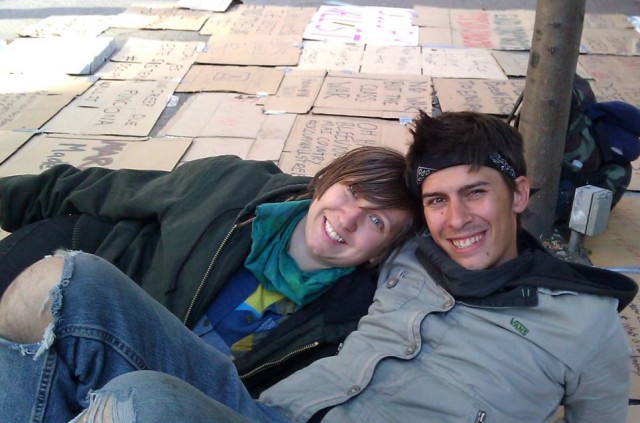
Zuccotti Park is a well-manicured, block-long park in the heart of New York City’s financial district that, for the past two days, has been home to a few hundred squatters, anarchists, activists, students, a few drug addicts, several undercover cops and one lone man in a suit. Alternately calling themselves Occupy Wall Street or Take Wall Street or the 99%, they have set up camp, spending the night on rolls of cardboard, yoga mats and bare concrete, as a protest against the abuses carried out by various financial institutions and banks against the people of this country.
The protest, loosely organized by Adbusters and the internet activist group Anonymous — although as groups of non-hierarchical activists tend to do, many protesters claimed no group affiliation or leadership — began on Saturday. Give or take, 5000 protesters marched down into the financial district banging drums and carrying signs, chanting “Wall Street, Our Street!” The group then set up camp in Zuccotti Park — a compromise, according to one protester, between the NYPD, protesters, and private owners of the park, so that the group did not just set up camp in the middle of the actual Wall Street. They spent Saturday and Sunday night in the small square, feasting on donated peanut butter, salads and cheese. On Sunday night, supporters of the protesters ordered the group pizza — so much pizza that the nearby pizza shop announced it would have to stay open until 1 a.m. just to fulfill orders. On Monday morning the group marched down Wall Street proper, beating drums and blowing whistles, and broadcasting a live stream of the whole thing on their website.
And on Sunday afternoon, protesters gathered in small groups to scrawl slogans on spare pieces of cardboard. They lounged on benches and congregated around the mountain of cans of Skippy that dominated the free food table. A line of protesters stood silently holding signs at the front of the park, somewhat peacefully facing off a gathering of cops. There were a few police vans surrounding the park, as well as officers milling around, but they seemed, for the most part, content to watch — making sure no one was smashing the windows of Starbucks or setting anything on fire, but otherwise staying out of the way.
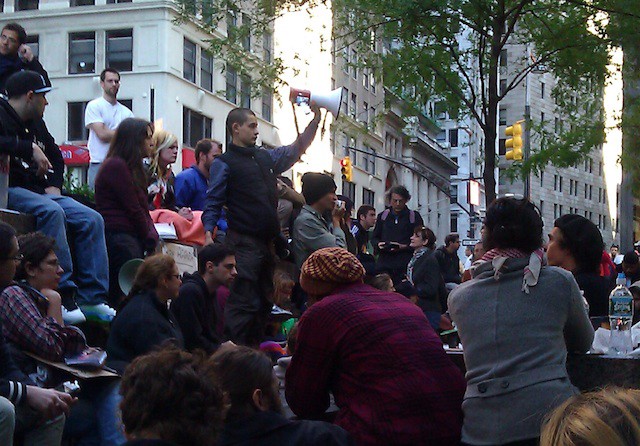
The group then held its “General Assembly,” the aggressively equitable open forum they use to make decisions. Five people with megaphones sat on a wall in front of the group, and encouraged the entire seated crowd to share ideas and contribute items to the agenda. The process was lengthy. It began with a review of the agenda, then suggestions for additional possible agenda items, with a chance for those who did not agree with the agenda items to dissent. Then it moved to discussion of the actual agenda items, and a conversation on whether items were to be decided by the entire group or moved to a smaller, subject-based work group that would bring their decision to the entire group, to then be further discussed. The process ensured that every single person had the chance to have their voice heard. It also meant that it took a very long time to get anything done.
“My neighbors are being pushed out of their homes through predatory lending and foreclosures, they’re having their heating and hot water being turned off, and my friends in college are so deep in student debt that they won’t pay it off for 20 years,” Justin told me. He is a fairly clean cut 25-year-old who had kicked off the megaphone portion of the day. He was monitoring the group’s food donation page on his iPad. “What we’re trying to do is trying to establish even more than we did yesterday, our encampment here, so we can achieve our ultimate goal, which is to occupy Wall Street and make our demands heard.”
Halfway through the General Assembly, a rowdy group of protesters, led by a man in tie-died spandex pants, approached the park. They were pounding drums, blowing whistles, and chanting “Wall Street, Our Street!” Their energy dissipated as they approached the more somber General Assembly, then in the process of discussing whether they should discuss a common name, if they should have a police liaison and how they could best formally recognize the disproportionate privilege of many of the protesters. Then a cry of “Welcome them!” came from the General Assembly, and the cheering, colorful band of marchers was added to the mix.
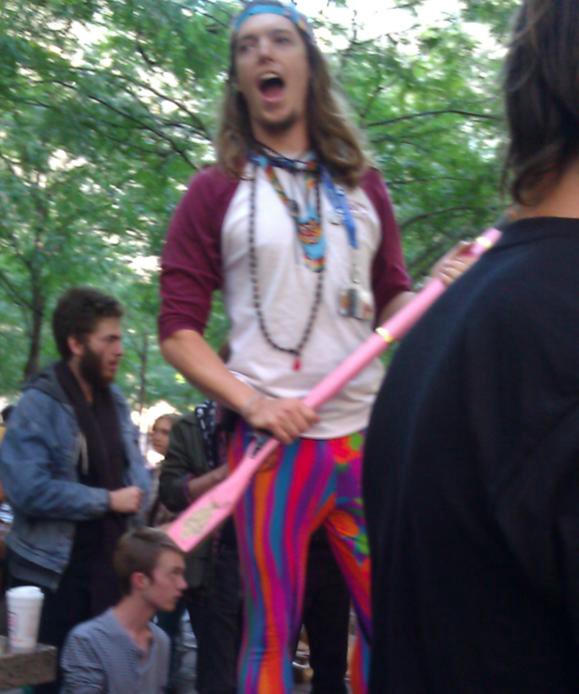
“Me personally — I don’t want to speak for everyone — but for me, it’s about getting money out of politics,” Benjamin Hitchock told me. He’s an 18 year-year-old college student who had driven down from Maine for the weekend. “It’s about getting the influence of money out of democracy. Because democracy was not made to represent the distribution of dollars, it was made to represent the distribution of beliefs.”
They had all been spending the night in the park, without tents or shelter, some more comfortably than others. Flip, a 23-year-old Queens resident with an acoustic guitar, told me that he’d forgotten a blanket the night before, so had been cold, but that everyone else had helped him get through.
“I just feel like I need to be here, you know?” Flip said. “I feel like the world is becoming a different place. That’s how it works, I guess.”
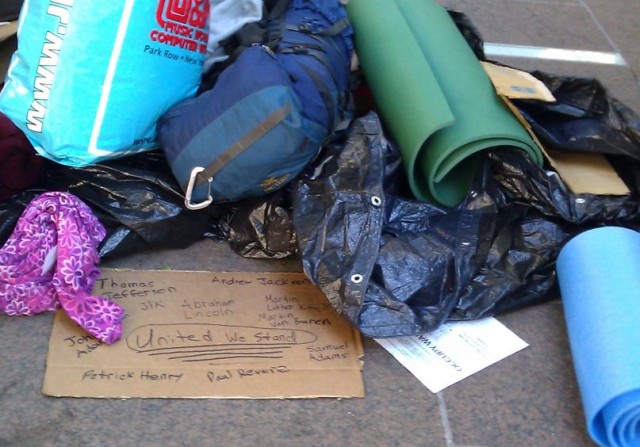
Some came from far away — Robert, a 20-something self-described professional activist who was lounging on cardboard with his girlfriend Caitlin, had hitchhiked across the country from California just to be there.
“What we’d like to change is to at least draw more attention to and hopefully phase out the financial system’s involvement in the political system,” Robert told me. “It kind of diminishes the voting power of individual people, it limits your choice to two candidates that have already been vetted by large contributors.”
Robert Segal, who said he was a 47-year-old former Wall Street employee and definitely was the lone protester there in a suit and tie, concurred. “No corporation should take home a senator for their mantelpiece, and have a congressperson on either side. When you throw money at a candidate you’re essentially casting a vote. And people should vote. Corporations shouldn’t vote. That’s a starting point.”
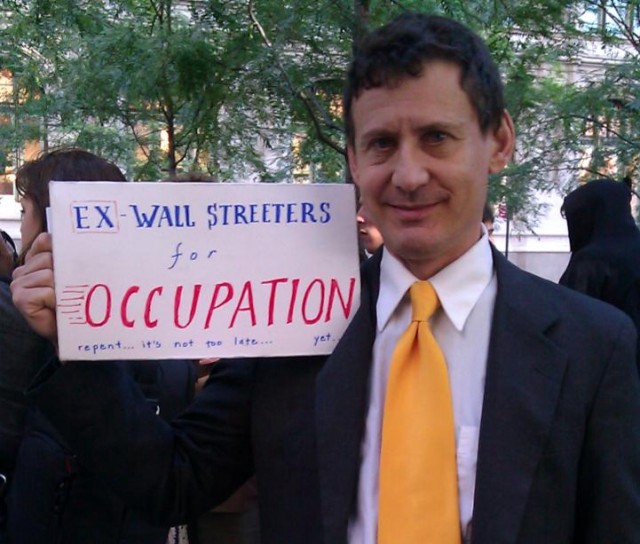
“After 2008, I expected wow, people are actually going to gather and go ‘what did you just do to us?’” he said. “’Why did you think you’re so vital, why don’t you take a hike? We don’t need you!’ But instead there was a resounding amount of non-noise.”
The most eventful part of the day was when a Big Apple Tour Bus pulled up, and tourists began to excitedly snap photos of the protesters in the park. At one point, a protester donned a Guy Fawkes mask — the signature of many members of Anonymous. A police officer walked up to him and, quietly, asked him to remove the mask. Wearing masks in New York City was illegal, he explained, and if the protester continued to wear it the officer would end up having to arrest him.
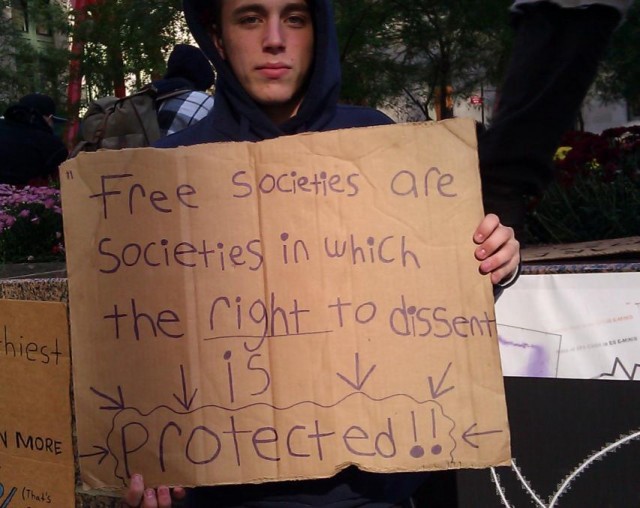
“I’m honestly shocked that there aren’t more people from the right,” Robert the hitchhiker said. “I’m surprised there aren’t more people from other sides. This is being spun as a very left-leaning cause, but ending the financial system’s stranglehold on our democracy is something everyone can agree on. All over the country in the Midwest, in red states, good old boys alike.”
“I know I’m making a difference,” Benjamin said. “The people who come and see this and walk by and think about it, whether it be good or bad thoughts. Plus,” he said, “If I wasn’t here, I’d just be sitting in my dorm room doing homework.”
Erica Sackin is a reporterer.
